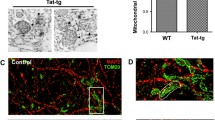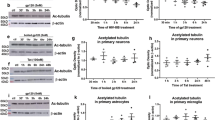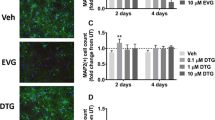Abstract
The human immunodeficiency virus 1 (HIV-1) protein Trans-activator of Transcription (Tat) is a nuclear regulatory protein that may contribute to the development of HIV-1 associated dementia by disrupting the neuronal cytoskeleton. The present studies examined effects of recombinant Tat(1-86; 1–100 nM) on microtubule-associated protein (MAP)-dependent and MAP-independent microtubule formation ex vivo and oxidative neuronal injury in rat organotypic hippocampal explants. Acute exposure to Tat(1-86) (≥1 nM) markedly reduced MAP-dependent and –independent microtubule formation ex vivo, as did vincristine sulfate (0.1–10 μM). Cytotoxicity, as measured by propidium iodide uptake, was observed in granule cells of the DG with exposure to 100 nM Tat(1-86) for 24 or 72 h, while significant reductions in MAP-2 immunoreactivity were observed in granule cells and pyramidal cells of the CA1 and CA3 regions at each timepoint. These effects were prevented by co-exposure to the soluble vitamin E analog Trolox (500 μM). Thus, effects of Tat(1-86) on the neuronal viability may be associated with direct interactions with microtubules and generation of oxidative stress.






Similar content being viewed by others
References
Adams SM, Aksenova MV, Aksenov MY et al (2010) ER-beta mediates 17 beta-estradiol attenuation of HIV-1 Tat-induced apoptotic signaling. Synapse 64(11):829–838
Aksenov MY, Aksenov MV, Mactutus CF et al (2009) Attenuated neurotoxicity of the transactivation-defective HIV-1 Tat protein in hippocampal cultures. Exp Neurol 219:586–590
Aksenov MY, Aksenova MV, Nath A et al (2006) Cocaine-mediated enhancement of Tat toxicity in rat hippocampal cell cultures: The role of oxidative stress and D1 dopamine receptor. Neurotoxicology 27:217–228
Aksenov MY, Hasselrot U, Wu G et al (2003) Temporal relationships between HIV-1 Tat induced neuronal degeneration, OX-42 immunoreactivity, reactive astrocytosis, and protein oxidation in the rat striatum. Brain Res 987(1):1–9
Allani PK, Sum T, Bhansali SG et al (2004) Comparative study of the effect of oxidative stress on the cytoskeleton in human cortical neurons. Toxicol Appl Pharmacol 196:29–36
Aprea S, Del Valle L, Mameli G et al (2006) Tubulin-mediated binding of human immunodeficiency virus-1 Tat to the cytoskeleton causes proteasomal-dependent degradation of microtubule-associated protein 2 and neuronal damage. J Neurosci 26:4054–4062
Archibald SL, Masliah E, Fennema-Notestine C et al (2004) Correlation of in vivo neuroimaging abnormalities with postmortem human immunodeficiency virus encephalitis and dendritic loss. Arch Neurol 61:369–376
Banks WA, Robinson SM, Nath A (2005) Permeability of the blood-brain barrier to HIV-1 Tat. Exp Neurol 193:218–227
Banks WA, Freed EO, Wolf KM et al (2001) Transport of human immunodeficiency virus type 1 pseudoviruses across the blood–brain barrier: role of envelope proteins and adsorptive endocytosis. J Virol 75:4681–4691
Battaglia PA, Zito S, Macchini A et al (2001) A Drosophila model of HIV-Tat related pathogenicity. J Cell Sci 114(Pt 15):2787–2794
Bhalla KN (2003) Microtubule-targeted anticancer agents and apoptosis. Oncogene 22:9075–9086
Bonavia R, Bajetto A, Barbero S et al (2001) HIV-1 Tat causes apoptotic death and calcium homeostasis alterations in rat neurons. Biochem Biophys Res Commun 288:301–308
Bruce-Keller AJ, Barger SW, Moss NI et al (2001) Pro-inflammatory and pro-oxidant properties of the HIV protein Tat in a microglial cell line: attenuation by 17 beta-estradiol. J Neurochem 78:1315–1324
Bruce-Keller AJ, Chauhan A, Dimayuga FO et al (2003) Synaptic transport of human immunodeficiency virus-Tat protein causes neurotoxicity and gliosis in rat brain. J Neurosci 23:8417–8422
Chauhan A, Turchan J, Pocernich C et al (2003) Intracellular human immunodeficiency virus Tat expression in astrocytes promotes astrocyte survival but induces potent neurotoxicity at distant sites via axonal transport. J Biol Chem 278:13512–13519
Chen D, Wang M, Zhou S et al (2002) HIV-1 Tat targets microtubules to induce apoptosis, a process promoted by the proapoptotic Bcl-2 relative Bim. EMBO J 21:6801–6810
de Mareuil J, Carre M, Barbier P et al (2005) HIV-1 Tat protein enhances microtubule polymerization. Retrovirology 2:5
Desai A, Mitchison TJ (1997) Microtubule polymerization dynamics. Annu Rev Cell Dev Biol 13:83–117
Egele C, Barbier P, Didier P et al (2008) Modulation of microtubule assembly by the HIV-1 Tat protein is strongly dependent on zinc binding to Tat. Retrovirology 5:62
Epie N, Ammosova T, Sapir T et al (2005) HIV-1 Tat interacts with LIS1 protein. Retrovirology 2:6
Eugenin EA, D’Aversa TG, Lopez L et al (2003) MCP-1 (CCL2) protects human neurons and astrocytes from NMDA or HIV-tat-induced apoptosis. J Neurochem 85:1299–1311
Garcia-Martinez LF, Ivanov D, Gaynor RB (1997) Association of Tat with purified HIV-1 and HIV-2 transcription preinitiation complexes. J Biol Chem 272:6951–6958
Giacca M (2005) HIV-1 Tat, apoptosis and the mitochondria: a tubulin link? Retrovirology 2:7
Gil L, Martinez G, Gonzalez I et al (2003) Contribution to characterization of oxidative stress in HIV/AIDS patients. Pharmacol Res 47:217–224
Gonzalez-Scarano F, Martin-Garcia J (2005) The neuropathogenesis of AIDS. Nat Rev Immunol 5:69–81
Jordan A, Hadfield JA, Lawrence NJ et al (1998) Tubulin as a target for anticancer drugs: agents which interact with the mitotic spindle. Med Res Rev 18:259–296
King JE, Eugenin EA, Buckner CM et al (2006) HIV tat and neurotoxicity. Microbes Infect 8:1347–1357
Kruman II, Nath A, Mattson MP (1998) HIV-1 protein Tat induces apoptosis of hippocampal neurons by a mechanism involving caspase activation, calcium overload, and oxidative stress. Exp Neurol 154:276–288
Liu Y, Jones M, Hingtgen CM et al (2000) Uptake of HIV-1 tat protein mediated by low-density lipoprotein receptor-related protein disrupts the neuronal metabolic balance of the receptor ligands. Nat Med 6:1380–1387
Ma M, Nath A (1997) Molecular determinants for cellular uptake of Tat protein of human immunodeficiency virus type 1 in brain cells. J Virol 71:2495–2499
Maragos WF, Tillman P, Jones M et al (2003) Neuronal injury in hippocampus with human immunodeficiency virus transactivating protein, Tat. Neuroscience 117:43–53
Mattson MP, Fu W, Waeq G et al (1997) Hydroxynonenal, a product of lipid peroxidation, inhibits dephosphorylation of the microtubule-associated protein tau. Neuroreport 8:2275–2281
Mishra M, Vetrivel S, Siddappa NB et al (2008) Clade-specific differences in neurotoxicity of human immunodeficiency virus-1 B and C Tat of human neurons: Significance of dicysteine C30C31 motif. Ann Neurol 63:366–376
Mizuhashi S, Ikegaya Y, Matsuki N (2000) Cytotoxicity of tributyltin in rat hippocampal slice cultures. Neurosci Res 38:35–42
Montine TJ, Amarnath V, Martin ME et al (1996) E-4-hydroxy-2-nonenal is cytotoxic and cross-links cytoskeletal proteins in P19 neuroglial cultures. Am J Pathol 148:89–93
Moore DJ, Masliah E, Rippeth JD et al (2006) Cortical and subcortical neurodegeneration is associated with HIV neurocognitive impairment. AIDS 20:879–887
Mulholland PJ, Stepanyan TD, Self RL et al (2005) Corticosterone and dexamethasone potentiate cytotoxicity associated with oxygen-glucose deprivation in organotypic cerebellar slice cultures. Neuroscience 136:259–267
Nath A, Psooy K, Martin C et al (1996) Identification of a human immunodeficiency virus type 1 Tat epitope that is neuroexcitatory and neurotoxic. J Virol 70:1475–1480
Neely MD, Sidell KR, Graham DG et al (1999) The lipid peroxidation product 4-hydroxynonenal inhibits neurite outgrowth, disrupts neuronal microtubules and modifies cellular tubulin. J Neurochem 72:2323–2333
Noraberg J, Kristensen BW, Zimmer J (1999) Markers for neuronal degeneration in organotypic slice cultures. Brain Res Protoc 3:278–290
Prendergast MA, Rogers DT, Mulholland PJ et al (2002) Neurotoxic effects of the human immunodeficiency virus type-1 transcription factor Tat require function of a polyamine sensitive-site on the N-methyl-D-aspartate receptor. Brain Res 954:300–307
Prendergast MA, Self RL, Smith KJ et al (2007) Microtubule-associated targets in chlorpyrifos oxon hippocampal neurotoxicity. Neuroscience 146:330–339
Price TO, Ercal N, Nakaoke R et al (2005) HIV-1 viral proteins gp120 and Tat induce oxidative stress in brain endothelial cells. Brain Res 1045:57–63
Sa MJ, Madeira MD, Ruela C et al (2004) Dendritic changes in the hippocampal formation of AIDS patients: a quantitative Golgi study. Acta Neuropathol 107:97–110
Self RL, Mulholland PJ, Harris BR et al (2004) Cytotoxic effects of exposure to the human immunodeficiency virus type 1 protein Tat in the hippocampus are enhanced by prior ethanol treatment. Alcohol Clin Exp Res 28:1916–1924
Self RL, Mulholland PJ, Nath A et al (2004) The human immunodeficiency virus type-1 transcription factor Tat produces elevations in intracellular Ca2 + that require function of an N-methyl-D-aspartate receptor polyamine-sensitive site. Brain Res 995:39–45
Singer EJ, Valdes-Sueiras M, Commins D et al (2010) Neurologic presentations of AIDS. Neurol Clin 28:253–275
Stoppini L, Buchs PA, Muller D (1991) A simple method for organotypic cultures in nervous tissue. J Neurosci Methods 37:173–182
Toborek M, Lee YW, Pu H et al (2003) HIV-Tat protein induces oxidative and inflammatory pathways in brain endothelium. J Neurochem 84(1):169–179
Turchan J, Pocernich CB, Gairola C et al (2003) Oxidative stress in HIV demented patients and protection ex vivo with novel antioxidants. Neurology 60:307–314
Wang LG, Liu XM, Kreis W et al (1999) The effect of antimicrotubule agents on signal transduction pathways of apoptosis: a review. Cancer Chemother Pharmacol 44:355–361
Westendorp MO, Shatrov VA, Schulze-Osthoff K et al (1995) HIV-1 Tat potentiates TNF-induced NF-kappa B activation and cytotoxicity by altering the cellular redox state. EMBO J 14:546–554
Williams DW, Kondo S, Krzyzanowska A et al (2006) Local caspase acitivity directs engulfment of dendrites during pruning. Nat Neurosci 9:1234–1236
Xu J, Ikez T (2009) The comorbidity of HIV-associated neurocognitive disorders and Alzheimer’s disease: a foreseeable medical challenge in post-HAART era. Neuroimmune Pharmacol 4:200–212
Acknowledgments
The authors acknowledge the support of AA013561.
Author information
Authors and Affiliations
Corresponding author
Rights and permissions
About this article
Cite this article
Butler, T.R., Smith, K.J., Self, R.L. et al. Neurodegenerative Effects of Recombinant HIV-1 Tat(1-86) are Associated with Inhibition of Microtubule Formation and Oxidative Stress-Related Reductions in Microtubule-Associated Protein-2(a,b). Neurochem Res 36, 819–828 (2011). https://doi.org/10.1007/s11064-011-0409-2
Accepted:
Published:
Issue Date:
DOI: https://doi.org/10.1007/s11064-011-0409-2




